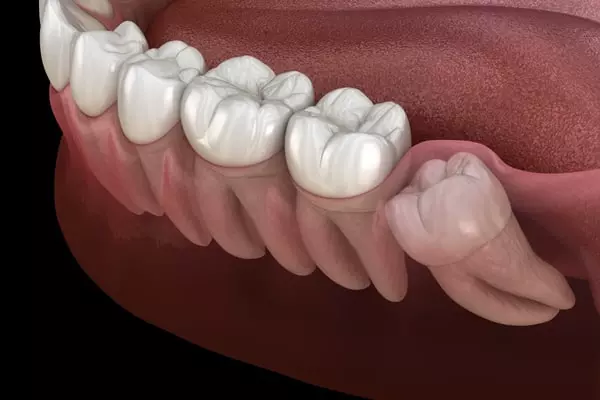Have you ever wondered do wisdom teeth ever stop growing? Wisdom teeth, or the third molars, are the last to come out at the back of the mouth behind the second molars. We generally have four wisdom teeth, one in each quadrant. Although these teeth commonly show signs of eruption between the ages of 17 and 21, it does not always happen at this specific age.; therefore, they may never develop and erupt around age 30.
Evolution has marked important changes in the diet of human beings; therefore, the dimensions of the mouth or jaws have decreased over time. Since the use of molars to chew hard foods is reduced, taking into account that current foods are softer and easier to chew. These third molars may not develop properly and sometimes can be in the wrong position or never erupt, causing adjacent dental problems that are sometimes painful.
Why do We have Wisdom Teeth?
Many people often ask why do have wisdom teeth if they cause problems, and it becomes necessary to extract them.
The answer lies in human evolutionary history. According to research, wisdom teeth were useful to nomadic men or our distant human ancestors who had overly large jaws and more teeth to help process rough, raw foods that required a lot of cutting and chewing.

Today we eat softer, cooked food with forks and knives. Thus, with evolution and this vast change in diet, people have smaller jaws with insufficient space for “extra” teeth. However, while all the teeth have held up well, There is often less or almost no space for the third molars to erupt, causing pain and discomfort, which is why most wisdom teeth are extracted.
Symptoms that Arise when Wisdom Teeth Come in
Some symptoms may occur when the wisdom teeth come in:
- Inflammation and redness behind the last teeth
- Pain or sensitivity in the jaw
- Pain in the face or cheeks since the eruption of the wisdom teeth puts pressure on the nerves.
- Sometimes white spots will appear on the gum behind the molars due to the emerging molars.
Click here to learn more about the signs of wisdom teeth coming in.
Why Should Wisdom Teeth be Removed?
An impacted wisdom tooth or third molar is one that cannot properly erupt into the oral cavity to achieve occlusion.
When the maxilla is very small and there is a second molar that erupted some time ago, it obstructs the passage of the wisdom tooth, preventing it from taking its normal position. he tooth continues to push, making the process painful and causing a diagonal or horizontal eruption instead of the vertical break in the surrounding jaw.
This can cause complications such as:
- Wisdom tooth pain
- Infection
- Cavities
- Gum disease
- Damage to neighboring teeth
- Cysts
- Tumors
Signs and Symptoms of Impacted Third Molars
The following are the signs and symptoms of impacted molars:
- Jaw pain
- Tender, swollen, or bleeding gums
- Bad breath
- Difficulty opening the mouth
- Unpleasant taste in the mouth
- Swelling around the jaw
If you experience any of these symptoms, it is recommended to visit the dentist as soon as possible.
Do Wisdom Teeth ever Stop Growing?
Wisdom teeth develop like any other tooth in the mouth. This happens when the first dental bud occurs and the development of the jaw begins. With the cellular union comes the formation of nervous tissues and the layers of the tooth. Slowly the upper part is formed and descends to the root. Thus, the formation of the third molars generally begins during the first years of life, between the ages of 7 to 10 years, but it takes a long time to complete the formation of the crown structure of the third molars.

The only difference that exists between the development and growth of third molars and other teeth is that wisdom teeth are the last to come out and present several stages of growth:
- By about 12 years of age, they are found below the gumlines.
- By the end of adolescence, the third molars have finished their development and are beginning to lengthen. (At this time, they can erupt.)
- At the age of 20, the teeth have either broken or have not erupted since they are impacted.
- At 40, the roots of the wisdom teeth are correctly and completely anchored to the jaws.
What are the Treatment Options?
In people with a large amount of space in the jaw, wisdom teeth can erupt in a straight line with other teeth and actually help with chewing. However, most of the time, wisdom teeth do not have enough space to erupt properly and grow to the side or are misaligned. Even without third molars, your bite has enough strength to function properly; therefore, the most effective solution to correct an impacted wisdom tooth is to extract it.
This means taking a preoperative x-ray, followed by careful exposure of the jawbone through a surgical procedure to remove the entire tooth structure without damaging the surrounding bone and soft tissue.
Does Early Removal of Wisdom Teeth Solve the Problem?
Wisdom teeth or partially erupted wisdom teeth often cause dental and oral problems such that many people have them removed as soon as they appear. Early removal can avoid pain, discomfort, and the risk of further damage to adjacent tissues and bone.
A 3D digital examination with a full mouth X-ray helps to evaluate the growth position of the third molars; the evaluation of the dental professional will determine the need for early extraction of wisdom teeth. This not only helps you escape future pain and discomfort but also benefits in other ways::
- Less crowding means fewer orthodontic problems
- Prevents damage to nearby teeth
- Lowers the risk of other oral problems and gum inflammation
- Reduces the chances of orofacial pain due to the eruption of third molars
- Prevents cysts, tumors, and damage to the jaw
- Prevents caries formation due to misalignment
Can Wisdom Teeth Grow Back After Extraction?
Indeed, it is possible. Some people have additional teeth; when the third molars are extracted when they are extracted, they may emerge. This condition is extremely rare and happens after having extracted the original wisdom teeth, called supernumerary teeth.
According to a study conducted in 2015, it is possible to observe adult patients with supernumerary teeth. the probability is low at approximately 2%. They can be anywhere in the mouth and are generally identified when control panoramic X-rays are taken or prior to the extraction of the wisdom teeth.
Contact us
If you have any questions about this or other topics, you can contact us at Channel Islands Family Dental as well as our page on Facebook. We look forward to your visit and we will make a timely diagnosis. Our dentists in Oxnard, Santa Paula, Ventura, Newbury Park, and Port Hueneme will be able to guide you toward the best treatment to take care of your health and give you back your best smile.
Bibliography
- Renton, T., & Wilson, NH (2016). Problems with erupting wisdom teeth: signs, symptoms, and management. The British journal of general practice : the journal of the Royal College of General Practitioners, 66(649), e606–e608. https://doi.org/10.3399/bjgp16X686509
- González Espangler, Liuba, Mok Barceló, Paula, de la Tejera Chillón, Alexis, George Valles, Yaimel, & Leyva Lara, Marvis Lisy. (2014). Characterization of the formation and development of third molars. MEDISAN, 18(1), 34-44.
- Demiriz, L., Durmuşlar, MC, & Mısır, AF (2015). Prevalence and characteristics of supernumerary teeth: A survey on 7348 people. Journal of International Society of Preventive & Community Dentistry, 5(Suppl 1), S39–S43. https://journals.lww.com/jpcd/fulltext/2015/05001/prevalence_and_characteristics_of_supernumerary.7.aspx
- Institute for Quality and Efficiency in Health Care (IQWiG). (May 7, 2020). Wisdom teeth: Overview. https://www.ncbi.nlm.nih.gov/books/NBK279591/
- Cleveland Clinic. (June 09, 2022). Wisdom Teeth. https://my.clevelandclinic.org/health/body/23223-wisdom-teeth
- Frothingham, S. (Sep 01, 2020). Can Wisdom Teeth Grow Back After They’ve Been Removed?. https://www.healthline.com/health/dental-and-oral-health/can-wisdom-teeth-grow-back
- Akshima S. (Sep 12, 2018). Why Don’t All Wisdom Teeth Descend in Adults?. https://www.news-medical.net/health/Why-Dont-All-Wisdom-Teeth-Descend-in-Adults.aspx
- Health Scotland. (Aug 04, 2022). Everything you need to know about teeth. https://www.nhsinform.scot/healthy-living/dental-health/your-teeth/everything-you-need-to-know-about-teeth

















